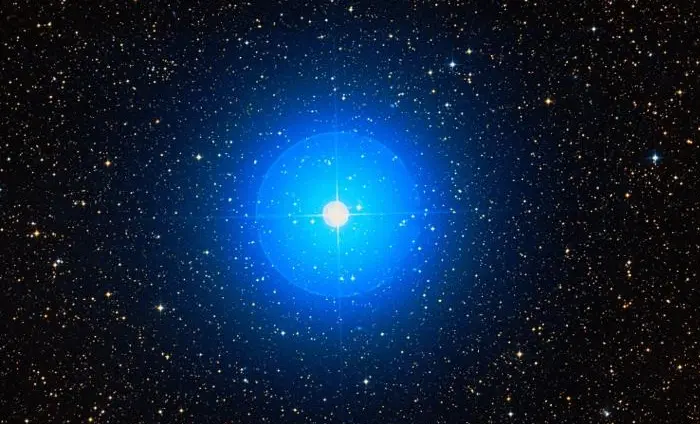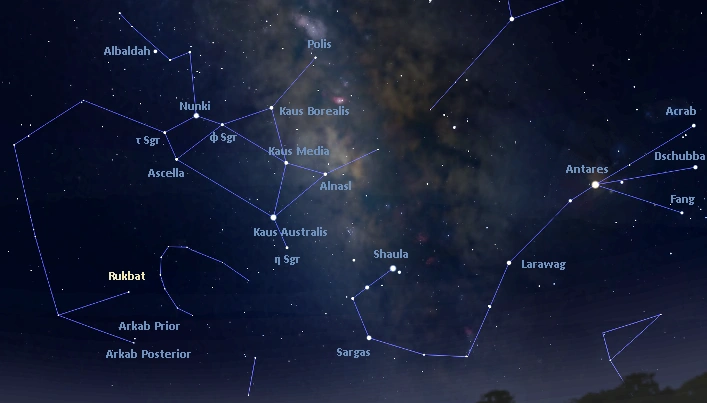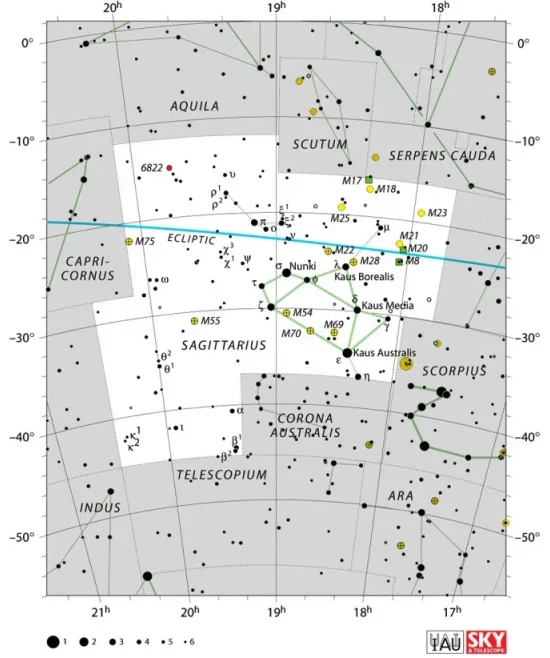Rukbat, Alpha Sagittarii (α Sgr), is a hot blue main sequence star located 182 light years away in the zodiac constellation of Sagittarius. With an apparent magnitude of 3.97, it is visible to the unaided eye. The luminous young star marks the celestial Archer’s knee.
Star type
Rukbat is a blue main sequence star of the spectral type B8 V. It has 2.95 times the Sun’s mass and a radius 2.69 times that of the Sun. With an effective temperature of around 12,837 K, it is 130 times more luminous than the Sun. It spins with a projected rotational velocity of 71 km/s.
Rukbat is still a very young star. It has an estimated age of only 33 million years. However, being almost 3 times more massive than the Sun, it will have a significantly shorter life than our parent star. When it reaches the end of its life cycle, Rukbat will cast away its outer layers of gas to form a planetary nebula and slowly cool and fade as a white dwarf.
In 2001, observations with the European Southern Observatory’s ADONIS (Adaptive Optics Near Infrared System) instrument revealed that Alpha Sagittarii was most likely a spectroscopic binary system. The ROSAT All Sky Survey had previously shown that the star emits an X-ray excess, which is unusual for a late B-type dwarf. The unseen companion is believed to be an active pre-main sequence star or a young star that has only reached the zero age main sequence.
Like the bright Vega, Rukbat shows an excess emission of infrared radiation, which indicates that it has a debris disk. The circumstellar disks of material that orbit stars can be produced in collisions of planetesimals. In older stars, they can also indicate the presence of mature planetary systems.

Rukbat (Alpha Sagittarii), ESO/Digitized Sky Survey 2 (CC BY 4.0)
Facts
Shining at magnitude 3.97, Rukbat is only the 16th brightest star in Sagittarius. It nevertheless has the Bayer designation Alpha Sagittarii, while the constellation’s brightest star, Kaus Australis, has the designation Epsilon Sagittarii. It is possible that Rukbat was considerably brighter at the time. In ancient Chaldean lore, the star was called Nibat Anu, meaning “chief star.”
German astronomer and uranographer Johann Bayer, who assigned the Greek letter designations to bright stars in the early 17th century, normally assigned the letters Alpha and Beta to the constellations’ brightest stars. In some instances, he went from north to south (Orion) or west to east (Ursa Major), but he usually followed the order of magnitude class if not individual brightness.
However, in the case of Sagittarius, the order appears arbitrary. The designation Beta Sagittarii is shared by two relatively faint star systems, Arkab Prior and Arkab Posterior. Meanwhile, the brightest stars in the constellation – Kaus Australis, Nunki and Ascella – were assigned the letters Epsilon, Sigma, and Zeta Sagittarii, respectively. In his star atlas Uranometria (1603), Bayer drew Alpha Sagittarii as much brighter than it is. It is possible that he never observed it directly but relied on Ptolemy’s notes (and possibly misinterpreted them).
The Simbad database lists Alpha Sagittarii as a probable member of the AB Doradus moving group, a loose stellar association that shares a similar age and motion through space. The members likely formed in the same molecular cloud at around the same time and are moving in the same general direction.
Other visible members of the moving group include Alnair (Alpha Gruis) in the constellation Grus, Mesarthim (Gamma2 Arietis) and Bharani (41 Arietis) in Aries, Gamma Doradus in Dorado, Delta Sculptoris in Sculptor, Kappa Piscium in Pisces, and Rho Telescopii in Telescopium. The quadruple star system AB Doradus, from which the group takes its name, shines at magnitude 6.98 – 7.06 and is invisible to the unaided eye.
In fiction, Rukbat was memorably used in Anne McCaffrey’s Dragonriders of Pern series of novels. The fictional Rukbat hosts a planetary system that includes Pern, the main setting of the novels.
Name
The name Rukbat (pronunciation: /ˈrʌkbæt/) comes from the Arabic phrase rukbat al-rāmī, meaning “the knee of the Archer.” It has the same etymology as the proper name of Delta Cassiopeiae (Ruchbah), one of the stars of Cassiopeia’s W. Alpha Sagittarii was historically also called Rucba, Ruchbah, Rukbah, Rucbar, Rukbat Al Rami, or Alrami (Al Rami, the Archer).
The International Astronomical Union’s (IAU) Working Group on Star Names (WGSN) approved the name Rukbat for Alpha Sagittarii on July 20, 2016.
In traditional Chinese astronomy, Rukbat was known as 天淵三 (Tiān Yuān sān), the Third Star of Celestial Spring. It formed the Celestial Spring asterism with Arkab Prior (Beta1 Sagittarii) and Arkab Posterior (Beta2 Sagittarii). The asterism represented a pond in the sky. It was part of the larger Dipper mansion, one of the mansions of the Black Tortoise.
In Arabic astronomy, Rukbat, Arkab Prior and Arkab Posterior were known as Al Ṣuradain, the desert birds (Surad).
Location
Rukbat lies in the southern part of the constellation Sagittarius, near the border with Corona Australis. It appears close to the imaginary line extended from Nunki (Sigma Sagittarii) through Ascella (Zeta Sagittarii) in the Teapot asterism.
Unlike the brighter stars of the Teapot, Rukbat is a more challenging target for observers in the mid-northern latitudes because it is much fainter and stays close to the horizon. The planetary nebula IC 1297 and the elliptical galaxy NGC 6768 appear in the region between the star and the fainter orange giant Beta Coronae Australis.
At declination -40° 37’, the star is best seen from the southern hemisphere. It never rises above the horizon for observers north of the latitude 49° N.

Rukbat location, image: Stellarium
Constellation
Rukbat is located in the constellation Sagittarius. The Archer is one of the 48 ancient constellations catalogued by Claudius Ptolemy of Alexandria in the 2nd century CE. In Greek mythology, it is associated with a centaur and with the satyr Crotus, who was credited for inventing archery. Sagittarius is typically depicted as aiming an arrow at the heart of the Scorpion, represented by the bright red supergiant Antares.
Sagittarius is the 15th largest constellation in the sky, occupying an area of 867 square degrees. It is one of the most distinctive southern constellations. Its brightest stars form an asterism known as the Teapot, which lies near the bright field of the Milky Way. The conspicuous star pattern can be used to find many bright star clusters and nebulae that appear in this region of the sky.
The constellation’s brightest star, the hot blue subgiant Kaus Australis (Epsilon Sagittarii), has an apparent magnitude of 1.85 and lies approximately 143 light-years away. The bright star forms the Archer’s bow with the slightly fainter Kaus Media (Delta Sagittarii) and Kaus Borealis (Lambda Sagittarii).

Sagittarius constellation map by IAU and Sky&Telescope magazine (Roger Sinnott & Rick Fienberg) (CC BY 3.0)
Other notable stars in the constellation include the triple star systems Zeta Sagittarii (Ascella) and Nu1 Sagittarii (Ainalrami), the hot blue main sequence stars Nunki (Sigma Sagittarii) and Arkab Prior (Beta1 Sagittarii), the variable blue supergiant Polis (Mu Sagittarii), the K-type giants Alnasl (Gamma2 Sagittarii) and Tau Sagittarii, the blue giant Phi Sagittarii, the yellow-white star Arkab Posterior (Beta2 Sagittarii), the red giant Eta Sagittarii, and the white subgiant Albaldah (Pi Sagittarii).
Sagittarius is also home to the Pinwheel Star (WR 104), the born-again star known as Sakurai’s Object (V4334 Sagittarii), the Peony Star (WR 102ka), the Pistol Star, the nearby red dwarf Ross 154, and the red supergiants KW Sagittarii and VX Sagittarii, both among the largest stars known.
Sagittarius hosts many deep sky objects that can be observed in binoculars and small telescopes. These include the open clusters Messier 18, Messier 23 and Messier 25, the globular clusters Messier 28, Messier 54, Messier 55, Messier 70 and Messier 75, the Small Sagittarius Star Cloud (Messier 24), the Lagoon Nebula (Messier 8), the Omega Nebula (Messier 17), and the Trifid Nebula (Messier 20).
Other deep sky objects in the constellation include the open clusters known as the Quintuplet Cluster and the Arches Cluster near the Galactic centre, Barnard’s Galaxy (Caldwell 57), the Sagittarius Dwarf Elliptical Galaxy, the planetary nebulae M1-42 (the Eye of Sauron Nebula), the Box Nebula (NGC 6445) and the Little Gem Nebula (NGC 6818), the globular clusters NGC 6544 and the Chandelier Cluster (NGC 6723), and Sagittarius A*, the Milky Way’s central black hole.
The best time of the year to see the stars and deep sky objects in Sagittarius is during the month of August, when the constellation is more prominent in the sky in the early evening. The entire constellation is visible from locations south of the latitude 55° N.
The 10 brightest stars in Sagittarius are Kaus Australis (Epsilon Sgr, mag. 1.85), Nunki (Sigma Sgr, mag. 2.05), Ascella (Zeta Sgr, mag. 2.59), Kaus Media (Delta Sgr, mag. 2.70), Kaus Borealis (Lambda Sgr, mag. 2.82), Albaldah (Pi Sgr, mag. 2.89), Alnasl (Gamma² Sgr, mag. 2.98), Eta Sagittarii (mag. 3.11), Phi Sagittarii (mag. 3.17), and Tau Sagittarii (mag. 3.326).
Rukbat – Alpha Sagittarii
| Spectral class | B8 V |
| U-B colour index | -0.33 |
| B-V colour index | -0.10 |
| Apparent magnitude | 3.97 |
| Absolute magnitude | +0.23 |
| Distance | 182 ± 2 light-years (55.7 ± 0.7 parsecs) |
| Parallax | 18.1088 ± 0.2890 mas |
| Radial velocity | -0.70 ± 4.1 km/s |
| Proper motion | RA: +31.790 ± 0.359 mas/yr |
| Dec.: −120.087 ± 0.302 mas/yr | |
| Mass | 2.95 M☉ |
| Luminosity | 130 L☉ |
| Radius | 2.69 R☉ |
| Temperature | 12,387 ± 421 K |
| Metallicity | -0.02 dex |
| Age | 33 million years |
| Rotational velocity | 71 km/s |
| Surface gravity | 4.11 cgs |
| Constellation | Sagittarius |
| Right ascension | 19h 23m 53.1753985532s |
| Declination | −40° 36′ 57.373929695″ |
| Names and designations | Rukbat, Alpha Sagittarii, Alpha Sgr, α Sagittarii, α Sgr, HD 181869, HR 7348, HIP 95347, SAO 325060, PPM 353699, FK5 728, CD−40°13245, CPD-40 8955, CPC 0 18143, SKY# 36082, ALS 16856, GC 26737, GCRV 11828, AKARI-IRC-V1 J1923531-403658, TD1 24515, TIC 98423184, RX J1923.8-4036, 1RXS J192354.0-403653, ROT 2780, GEN# +1.00181869, GSC 07935-02139, WEB 16665, IRAS 19204-4042, IRAS F19204-4042, 2MASS J19235315-4036571, UBV 16392, UBV M 23709, uvby98 100181869, TYC 7935-2139-1, Gaia DR2 6713727061308648704, Gaia DR3 6713727061309245952 |